There’s something magical about a well-made pavlova. That delicate balance between the crisp exterior and marshmallowy center makes my heart skip a beat every time I serve it to friends and family. While traditional pavlovas are divine on their own, I’ve discovered that adding a few dashes of Angostura Orange Bitters elevates this classic dessert to new heights. The subtle citrus notes complement the sweetness perfectly, creating a sophisticated flavor profile that will have your guests asking for your secret ingredient.
The History Behind the Pavlova
Before we dive into the recipe, let me share some background on this beloved dessert. The pavlova is named after Russian ballerina Anna Pavlova, who toured Australia and New Zealand in the 1920s. Both countries claim to be the birthplace of this meringue-based dessert, and the debate continues to this day. What we do know is that it was created to honor the dancer’s lightness and grace – qualities perfectly captured in the dessert’s airy texture.
I’ve been perfecting my pavlova recipe for years, and the addition of Angostura Orange Bitters was a happy accident during a summer dinner party when I was looking for a way to enhance the citrus notes. The result was so spectacular that it’s become my signature version.
Understanding the Ingredients
Each component in a pavlova plays a crucial role in achieving that perfect texture and flavor balance:
Egg whites : The foundation of any meringue. They must be at room temperature to achieve maximum volume when whipped.
Caster sugar : Finer than granulated sugar, it dissolves more easily into the egg whites for a smooth meringue.
Cornstarch : Helps create that soft, marshmallowy center by preventing the egg proteins from tightening too much.
White vinegar : Stabilizes the egg whites and helps maintain that perfect chewy interior.
Angostura Orange Bitters : Adds subtle citrus complexity without additional liquid that could compromise the meringue structure.
Vanilla extract : Brings depth and warmth to balance the sweetness.
The Science Behind the Perfect Pavlova
What makes pavlova so special is the textural contrast between the crisp shell and the soft interior. This isn’t just luck – it’s chemistry! When you beat egg whites, you’re creating a protein network that traps air bubbles. The sugar stabilizes this foam by drawing out moisture, while the acid (vinegar) and cornstarch prevent the proteins from tightening too much during baking.
The slow baking process is crucial: the outside dries out and becomes crisp, while the inside remains soft and marshmallowy. The cooling process in the oven prevents the sudden temperature change that would cause the pavlova to crack dramatically (though some cracking is normal and gives it that rustic charm).
Essential Equipment
Before starting, make sure you have these items on hand:
- Stand mixer or hand-held electric beaters
- Large, clean mixing bowl (preferably metal or glass)
- Parchment paper
- Baking sheet
- Spatula
- Measuring cups and spoons
- Airtight container for storage
The Recipe: Citrus Pavlova with Angostura Orange Bitters
Ingredients for the Meringue Base
| Ingredient | Quantity | Notes |
|---|---|---|
| Egg whites | 4 large (about 120g) | Room temperature |
| Caster sugar | 1 cup (200g) | Must be added gradually |
| Cornstarch | 1 tablespoon (10g) | Helps achieve marshmallowy center |
| White vinegar | 1 teaspoon (5ml) | Stabilizes the meringue |
| Angostura Orange Bitters | 3-4 dashes | Our secret flavor enhancer |
| Vanilla extract | 1 teaspoon (5ml) | Pure, not imitation |
| Salt | Pinch | Enhances flavors |
Ingredients for the Topping
| Ingredient | Quantity | Notes |
|---|---|---|
| Heavy cream | 1½ cups (360ml) | Cold from refrigerator |
| Powdered sugar | 2 tablespoons (16g) | Stabilizes whipped cream |
| Vanilla extract | ½ teaspoon (2.5ml) | For flavor |
| Angostura Orange Bitters | 2 dashes | For the cream |
| Fresh citrus fruits | 2 cups mixed | Oranges, blood oranges, mandarin, etc. |
| Berries | 1 cup | Strawberries, raspberries, blueberries |
| Passion fruit | 2-3 | For dramatic presentation |
| Mint leaves | Small handful | For garnish |
| Orange zest | From 1 orange | For garnish |
Step-by-Step Instructions
Preparing the Meringue
- Preheat your oven to 275°F (135°C). Line a baking sheet with parchment paper and draw an 8-inch circle on it as a guide. Flip the paper over so the pencil mark is on the underside.
- Ensure all equipment is scrupulously clean. Any fat residue will prevent egg whites from whipping properly.
- Begin whipping the egg whites in a stand mixer on medium speed until soft peaks form. This usually takes about 2 minutes.
- Add the caster sugar very gradually, about a tablespoon at a time, while continuing to beat. This slow addition is crucial for a stable meringue. The entire process should take about 8-10 minutes.
- Test the meringue by rubbing a small amount between your fingers – it should feel smooth, not grainy. If it’s still grainy, continue beating.
- When the meringue is glossy and holds stiff peaks, gently fold in the cornstarch, vinegar, Angostura Orange Bitters, vanilla extract, and salt with a spatula. Use a light hand to maintain as much air as possible.

Shaping and Baking
- Spoon the meringue onto the prepared baking sheet, using the circle as a guide. Create a slight depression in the center where the filling will go.
- Use a spatula to shape the sides upward, creating a nest-like structure.
- Place in the preheated oven and immediately reduce the temperature to 250°F (120°C).
- Bake for 1 hour and 15 minutes. The exterior should be crisp and pale cream in color.
- Turn off the oven and leave the pavlova inside with the door closed for at least 2 hours or overnight. This gradual cooling prevents excessive cracking.
Preparing the Topping
- In a clean bowl, whip the cold heavy cream with the powdered sugar, vanilla extract, and Angostura Orange Bitters until soft peaks form. Be careful not to overwhip.
- Prepare the fruit by slicing citrus into thin rounds or segments, halving strawberries, and cleaning other berries.
- Cut open the passion fruit and set aside the pulp and seeds.
Assembly (do this within 2 hours of serving)
- Carefully transfer the pavlova base to a serving platter.
- Spread the whipped cream generously over the center depression.
- Arrange the fruit attractively on top of the cream. Start with larger fruit pieces and work your way to smaller ones.
- Spoon the passion fruit pulp over the arrangement for a vibrant finish.
- Garnish with mint leaves and a light dusting of orange zest.

Critical Techniques and Troubleshooting
Achieving the Perfect Meringue
| Issue | Possible Cause | Solution |
|---|---|---|
| Meringue won’t whip to stiff peaks | Egg whites too cold | Ensure eggs are at room temperature |
| Fat contamination | Use clean equipment, separate eggs carefully | |
| Meringue weeps or becomes watery | Sugar added too quickly | Add sugar 1 tablespoon at a time |
| Humid environment | Try making on a dry day, or use air conditioning | |
| Pavlova cracks excessively | Oven temperature too high | Ensure proper temperature, use an oven thermometer |
| Cooled too quickly | Cool slowly in the oven with door closed | |
| Pavlova collapses completely | Undercooked | Ensure full baking time |
| Overmixed after adding dry ingredients | Fold gently and minimally | |
| Sticky meringue | Humidity during cooling | Use a dehumidifier in the kitchen if needed |
| Underbaked | Extend baking time slightly |
Storage and Make-Ahead Tips
The unbaked meringue doesn’t hold well, but once baked, the shell can be stored in an airtight container for up to 2 days before adding toppings. Here are my tested storage methods:
- Baked pavlova shell: Store in an airtight container at room temperature (not in the refrigerator, which can make it soggy). Place a small packet of silica gel in the container if you live in a humid climate.
- Assembled pavlova: Best eaten within 3-4 hours of assembly. The moisture from the cream and fruit will gradually soften the meringue – which some people actually prefer!
- Whipped cream: Can be prepared up to 24 hours ahead and refrigerated.
- Fruit: Prepare just before assembly for the freshest appearance.
Variations to Try
While this citrus version with Angostura Orange Bitters is my favorite, here are some other variations I’ve experimented with:
Tropical Pavlova
Replace the orange bitters with a tiny bit of coconut extract in the meringue, and top with mango, pineapple, and toasted coconut flakes.
Chocolate-Berry Pavlova
Fold 2 tablespoons of cocoa powder into the meringue mixture and top with mixed berries and a drizzle of dark chocolate.
Rose and Pistachio Pavlova
Add a few drops of rose water instead of orange bitters to the meringue, and top with crushed pistachios and fresh raspberries.

Serving Suggestions
I love to serve pavlova as the crowning glory of a summer dinner party. Here are some pairing ideas:
- A refreshing citrus spritzer made with sparkling water, fresh orange juice, and a dash of Angostura Orange Bitters
- A selection of herbal teas, particularly those with citrus or floral notes
- Homemade lemonade with orange slices
- An iced coffee with orange zest for contrast
Nutrition Information
While pavlova is definitely a treat, it’s actually lower in fat than many other desserts when made with fresh fruit. Here’s an approximate breakdown per serving (based on 8 servings):
| Nutrient | Amount | % Daily Value |
|---|---|---|
| Calories | 275 kcal | 14% |
| Carbohydrates | 42g | 15% |
| Sugars | 38g | 42% |
| Protein | 3g | 6% |
| Fat | 11g | 14% |
| Saturated Fat | 7g | 35% |
| Cholesterol | 41mg | 14% |
| Sodium | 68mg | 3% |
| Potassium | 198mg | 6% |
| Vitamin C | 18mg | 22% |
| Calcium | 42mg | 4% |
| Iron | 0.3mg | 2% |
Frequently Asked Questions
Q: Why did my pavlova collapse after baking?
A: Several factors can cause collapse. The most common are underbaking, cooling too quickly, or overmixing after adding the cornstarch and vinegar. Make sure to follow the slow cooling instructions exactly – leave it in the oven with the door closed.
Q: Can I make mini pavlovas instead of one large one?
A: Absolutely! The recipe makes approximately 8-10 individual pavlovas. Reduce the baking time to about 50 minutes, but still allow them to cool slowly in the oven.
Q: What if I can’t find Angostura Orange Bitters?
A: While the orange bitters add a special note, you can substitute with 1/2 teaspoon of orange extract or 1 teaspoon of orange zest. The flavor profile will be slightly different but still delicious.
Q: My pavlova always seems to crack. Is this normal?
A: Some cracking is completely normal and gives pavlova its rustic charm. Excessive cracking can be reduced by ensuring your oven isn’t too hot and by cooling the pavlova slowly in the oven.
Q: Can I make this recipe without sugar or with a sugar substitute?
A: Unfortunately, the sugar in this recipe is structural, not just for sweetness. It creates the unique texture of the pavlova. Sugar substitutes generally don’t work well for meringues as they don’t interact with the egg proteins in the same way.
Q: How far in advance can I assemble the pavlova?
A: Ideally, assemble the pavlova no more than 3-4 hours before serving. The moisture from the cream and fruit will slowly soften the meringue shell.
Q: Why does the recipe call for cornstarch?
A: Cornstarch helps create that distinctive marshmallowy center by preventing the egg proteins from tightening too much during baking.
Q: Is there a dairy-free alternative for the cream topping?
A: Yes! Whipped coconut cream makes an excellent dairy-free alternative. Refrigerate a can of full-fat coconut milk overnight, scoop out the solid cream that rises to the top, and whip it with powdered sugar just as you would dairy cream.
Final Thoughts
The pavlova is more than just a dessert in my kitchen – it’s a celebration of texture and flavor that never fails to impress. The addition of Angostura Orange Bitters might seem unconventional, but it’s one of those small touches that makes all the difference.
Remember that making the perfect pavlova takes practice, so don’t be discouraged if your first attempt isn’t picture-perfect. Each one has its own character, and even the ones that crack or collapse a bit still taste wonderful. The joy is in the process and, of course, in sharing the results with loved ones.
I hope this recipe inspires you to create your own pavlova masterpiece. The combination of crisp meringue, pillowy interior, tangy citrus, and fresh fruit makes for a dessert that’s as beautiful as it is delicious. Happy baking!


